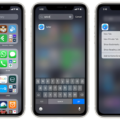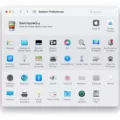Mac computers are known for their smooth performance and reliability. However, there may come a time when you encounter issues with your Mac, particularly with Safari, the default web browser. Safari may freeze, become unresponsive, or even crash, causing frustration and hindering your productivity. In this article, we will explore the possible causes of these problems and provide some solutions to help you get your Mac and Safari back on track.
1. Insufficient Resources:
One common reason for Safari getting stuck on a Mac is the lack of available resources. When you have multiple applications running simultaneously or numerous tabs open in Safari, it can overload your system’s memory (RAM) and slow down its performance. To resolve this issue, you can clear your RAM by using a tool like MacKeeper. Follow these steps:
– Press the Option (or Alt), Command, and Esc keys together to open the “Force Quit Applications” window.
– Select Safari and click the “Force Quit” button.
2. Outdated Software:
Another factor that can cause Safari to freeze or become unresponsive is outdated software. If you haven’t updated your Mac’s operating system or Safari browser, it’s possible that compatibility issues are at play. To fix this problem, follow these steps:
– Click on the Apple logo in the menu bar and select “System Preferences.”
– Choose “Software Update” and install any available updates for both macOS and Safari.
3. Corrupted Cache and Cookies:
The cache and cookies stored by Safari can also impact its performance. Over time, these files can become corrupted or overloaded, leading to freezing or crashing issues. Clearing the cache and cookies can often resolve this problem. Here’s how:
– Open Safari and click on “Safari” in the menu bar.
– Select “Preferences” and go to the “Privacy” tab.
– Click on “Manage Website Data” and remove all data by clicking “Remove All.”
– Additionally, you can clear the cache by selecting “History” in the menu bar and choosing “Clear History.”
4. Conflicting Extensions or Plugins:
Sometimes, Safari extensions or plugins can conflict with the browser, causing it to freeze or crash. To identify and remove problematic extensions, follow these steps:
– Open Safari and click on “Safari” in the menu bar.
– Select “Preferences” and go to the “Extensions” tab.
– Disable or remove any suspicious or unnecessary extensions.
5. Resetting Safari:
If none of the above solutions work, resetting Safari to its default settings can often resolve persistent issues. Here’s how:
– Open Safari and click on “Safari” in the menu bar.
– Select “Preferences” and go to the “Advanced” tab.
– Check the box next to “Show Develop menu in menu bar.”
– Close the Preferences window and click on “Develop” in the menu bar.
– Select “Empty Caches” and “Reset Safari.”
Experiencing issues with Safari on your Mac can be frustrating, but there are solutions available to resolve them. By following the steps outlined in this article, you can clear your RAM, update your software, clear cache and cookies, remove conflicting extensions, and reset Safari. Implement these troubleshooting methods, and you’ll likely find that your Mac and Safari will be back to smooth sailing in no time.

Why Does Safari Keep Freezing On Your Mac?
There could be several reasons why Safari keeps freezing on your Mac. Here are some possible causes:
1. Insufficient RAM: If your Mac doesn’t have enough available memory, it can cause Safari to freeze. When you have multiple apps and tabs open, it puts a strain on your system resources, leading to freezing issues.
2. Outdated Safari version: Using an outdated version of Safari may lead to compatibility issues with your operating system or other software on your Mac. Updating to the latest version of Safari can help resolve freezing problems.
3. Extension conflicts: Safari extensions can enhance your browsing experience, but incompatible or poorly designed extensions can cause freezing. Try disabling or removing any recently installed extensions to see if the freezing issue persists.
4. Corrupted cache or cookies: Over time, Safari accumulates temporary files, cache, and cookies that can become corrupt and cause freezing. Clearing your browsing data can help resolve this issue.
5. Mac software conflicts: Sometimes, other software running on your Mac can conflict with Safari and cause freezing. Ensure that all your software, including plugins and add-ons, are up to date and compatible with your Mac’s operating system.
6. Hardware issues: In rare cases, hardware problems such as a failing hard drive or insufficient disk space can cause Safari to freeze. Check your Mac’s disk space and run diagnostic tests to rule out any hardware-related issues.
To prevent Safari from freezing on your Mac, try the following:
– Close unnecessary tabs and applications to free up system resources.
– Update Safari and your Mac’s operating system to the latest versions.
– Disable or remove any problematic extensions.
– Clear your browsing data, including cache and cookies, regularly.
– Keep all your software up to date and ensure compatibility with your Mac.
– Monitor your Mac’s hardware health and address any issues promptly.
If the freezing issue persists, consider seeking professional help from an Apple support representative or a certified technician to diagnose and resolve the problem.
What Causes Safari to Stop Responding?
There can be several reasons why Safari stops responding on your iPhone. Here are some possible causes:
1. Outdated iOS version: Safari may stop working if you are using an outdated version of iOS. Updating your device to the latest iOS version can fix this issue.
2. App conflicts: Sometimes, other apps on your iPhone may conflict with Safari, causing it to freeze or crash. Updating all your apps to the latest versions can help resolve these conflicts.
3. Cache and data overload: Accumulated cache and data can overload Safari, leading to performance issues. Clearing the cache and data regularly can help prevent Safari from becoming unresponsive.
4. Internet connectivity problems: Poor or unstable internet connection can also cause Safari to stop responding. Ensure you have a stable internet connection or try switching to a different network to see if that resolves the issue.
5. Website compatibility issues: Certain websites may not be fully compatible with Safari or may contain problematic elements that cause the browser to freeze. Try accessing different websites to determine if a specific website is causing the problem.
6. Memory issues: If your device is running low on memory, Safari may become unresponsive. Close unnecessary apps running in the background or restart your device to free up memory.
7. Software glitches: Occasionally, software glitches or bugs in iOS can cause Safari to malfunction. Updating iOS or performing a software reset can often resolve these issues.
If Safari continues to have problems, you may need to contact Apple Support or visit an Apple Store for further assistance.
Why is Safari Not Quitting On Your Mac?
There can be several reasons why Safari may not be quitting on your Mac. Here are some possible causes:
1. Unresponsive Website: If Safari is stuck on a webpage that is not responding, it may prevent the browser from quitting. In such cases, you can try force quitting Safari using the key combination Option + Command + Esc or by selecting “Force Quit” from the Apple menu.
2. Background Processes: Safari may have certain background processes running that are preventing it from quitting. You can check for any active Safari processes by opening the Activity Monitor (you can find it in the Utilities folder within the Applications folder), searching for “Safari” in the search bar, and force quitting any related processes.
3. Extensions or Plugins: Certain extensions or plugins installed in Safari can cause it to become unresponsive or prevent it from quitting properly. You can try disabling or removing any recently installed extensions or plugins and then attempt to quit Safari again.
4. Software Issues: Sometimes, software issues can cause Safari to hang or not quit properly. It’s a good idea to ensure that your Mac is running the latest version of macOS and that Safari is up to date. You can check for software updates in the System Preferences and App Store.
5. System Resource Usage: If your Mac is running low on system resources, it may affect the performance of Safari and prevent it from quitting. You can try closing any unnecessary applications or restarting your Mac to free up system resources.
If none of these solutions work, you may need to consider further troubleshooting steps or seek assistance from Apple Support or an experienced Mac technician.
How Do You Unfreeze Safari On a Macbook Air?
To unfreeze Safari on a MacBook Air, you can follow these steps:
1. Press the “Command-Option-Esc” keys simultaneously. This will launch the “Force Quit Applications” window.
2. Alternatively, you can click the Apple logo in the menu bar and select “Force Quit” to open the same window.
3. In the “Force Quit Applications” window, locate and select “Safari” from the list of running applications.
4. Once “Safari” is selected, click on the “Force Quit” button.
5. Safari will then be forcefully closed, and any frozen or unresponsive processes will be terminated.
6. After force quitting Safari, you can relaunch it by clicking on the Safari icon in your dock or by searching for it in Spotlight.
By following these steps, you should be able to unfreeze Safari on your MacBook Air and resume using the browser without any issues.
Conclusion
The Mac operating system offers a range of features and functionalities that make it a popular choice for users around the world. With its sleek design, intuitive interface, and powerful performance, Mac provides a seamless and efficient user experience.
One of the standout features of Mac is its ability to handle multiple applications and tasks simultaneously without compromising on performance. The powerful hardware and optimized software work together to ensure smooth and efficient multitasking, allowing users to run numerous apps, browse the web, and perform various tasks without any lag or slowdown.
Additionally, Mac offers a robust and secure browsing experience with its Safari browser. However, like any other software, Safari can encounter issues such as freezing or crashing due to excessive resource usage. Clearing the RAM can help resolve these issues and improve overall system performance.
Furthermore, Mac provides users with the option to force quit applications that are unresponsive or causing issues. This feature allows users to quickly close problematic apps and regain control of their system.
Mac offers a reliable and user-friendly platform that caters to the needs of both casual users and professionals. With its powerful performance, sleek design, and intuitive interface, Mac continues to be a top choice for individuals looking for a seamless and efficient computing experience.








